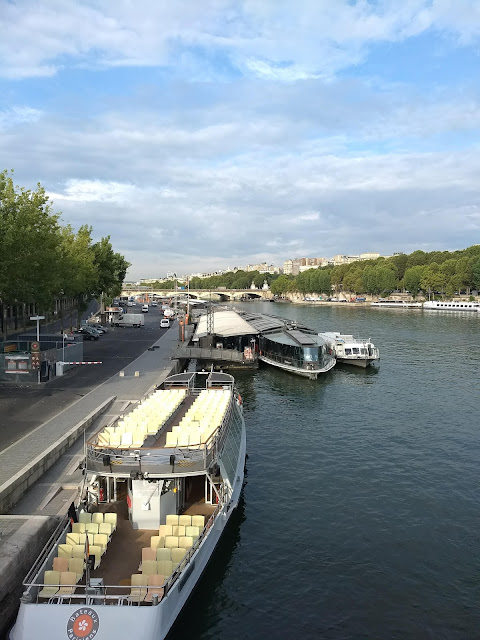 |
| The vegetated wall on the Quai Branly. I especially adore the blooming hosta lilies. |
In the good old days, Banani's management didn't hesitate to turn on the air conditioning when evenings were warm -- or hot. Something happened, however, and subsequently the Banani management did not seem to care anymore.
And then Banani disappeared. An empty restaurant remained. We were sad.
Yesterday, as I browsed through lafourchette.com, looking for nearby Indian restaurants with high ratings, I found a new place called Indian Villa. It had only 10 reviews, but all ten gave the restaurant 10 points (the highest level). The few reviews on TripAdvisor were equally glowing. Indian Villa just opened on July 14 -- Bastille Day.
When I noticed that Indian Villa's address was on the rue de la Croix Nivert, my appetite awakened. Sure enough, when I checked the photographs for the restaurant's lafourchette.com page, I recognized the glossy, deep red mahogany paneling with gold trim and fancy carvings.
 |
| The beautiful Lavirotte building at 29 Avenue Rapp. |
People who really care about good Indian cuisine have returned to that precious spot where Banani had been. I asked Tom if he was interested in dining there last night, and he was enthusiastic -- even before I told him that lafourchette.com was offering a 40 percent discount because it was Monday. And so I reserved.
We opened the heavy, wooden door and were warmly welcomed. We felt the cool drift of air conditioning as we were shown to our table.
We ordered our usual Indian favorites: vegetable pakora (shared), lamb korma for each, basmati rice for Tom, naan, garlic naan, and for dessert, we shared a Dame Blanche.
Everything was perfect -- the food, the service, the serving sizes, the discounted check.
Indian Villa is encouraging take out orders, too. These are offered at a slight discount off the eat-in prices. We were given a glossy paper takeout menu to take home with us.
Good Indian food is not cheap. It is not like Chinese food that way, and I do not understand people who think it should be.
Indian food is complex. I did not attempt to make it much until I subscribed to meal kits. I've done Blue Apron, Home Chef, and Plated so far. When we return, I'm going to subscribe to SunBasket.
I was thinking about those meal kits yesterday and wondered if they exist in France. They do!
 |
| A cute creperie next to a Chinese restaurant on the rue de Pondichéry. |
With all the restaurants within walking distance around us, I have not felt the urge to cook that much in Paris -- until this year. What I found that I love so much about the meal kits at home is that I do not have to do the planning and shopping. I do not like to shop. Thankfully, Tom does.
The meal kits brought home to me how very much I DO like to cook.
 |
| Gangplank to the archipelago on the Seine is raised until 10AM. |
Cooking is difficult in the kitchen of the apartment where we stay in Paris, because that kitchen is small and it is crammed full of the owner's stuff. So I don't cook, except for the occasional scrambled eggs, omelettes, poached eggs, French toast, salads of all sorts, and charcuterie or cheese plates. But it would be nice to be able to do complex dishes . . . .
This, plus some other factors, now have us considering the idea of renting an apartment year-round in Paris -- one that we can furnish, one with a decent kitchen, even if it is a small kitchen.
We could only be here for six months, but I know others in our family could use it much of the rest of the time.
It is a thought. We are thinking about it. It is worth considering. Stay tuned.

































































